Superman: Doomsday
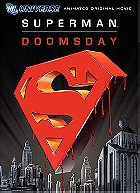 Posted : 14 years, 8 months ago on 12 September 2010 01:30
(A review of Superman: Doomsday)
Posted : 14 years, 8 months ago on 12 September 2010 01:30
(A review of Superman: Doomsday)Superman: Doomsday is the first of the direct-to-DVD animated features from Warner Brothers animation. Produced by Bruce Timm, the main creative force behind the beloved DCAU from the early-90s to mid-00s, and armed with a PG-13 rating, it had tremendous potential to really be something. As it turned out, it’s good, but never really great. A rushed and frantically paced adaptation of the death and return of Superman storylines, Doomsday combines the mainstream news headline making storylines into an excuse to hang two large scale action sequences and opening and closing monologues from Lex Luthor. Problems with the script aside, fantastic animation and great vocal work could have allowed one to overlook the deficiencies in the script. And while the animation is frequently great it is also marked by numerous problems. Superman’s design being chief among them, and his body which looks grossly disproportioned towards the end. The action sequences as wonderful to behold though, and put much of Superman Returns and other live action attempts to shame. And on the vocal side of things, James Marsters and Adam Baldwin deliver the goods as Luther and Superman, but the less said about the woefully miscast Swoosie Kurtz, Cree Summer and Anne Heche as Ma Kent, Mercy Graves and Lois Lane, the better. Altogether, it’s not awful, and it would be bettered by the rest of the direct-to-DVD films, but it’s obvious that they had to start somewhere.
 0 comments, Reply to this entry
0 comments, Reply to this entry
Justice League: Crisis on Two Earths
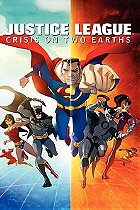 Posted : 14 years, 8 months ago on 12 September 2010 01:29
(A review of Justice League: Crisis on Two Earths)
Posted : 14 years, 8 months ago on 12 September 2010 01:29
(A review of Justice League: Crisis on Two Earths)Based on the 1964 storyline “Crisis on Earth-Three!” and the 2000 Grant Morrison-penned JLA: Earth 2 graphic novel, Justice League: Crisis on Two Earths tells a story in which the Justice League are the supervillains on one Earth and Lex Luthor leads the Justice League. Luthor, as the only surviving member, launches himself into the normal DC universe and asks for their help. What follows is a beautifully animated film that features a taunt script and some nice vocal work. Chief among of the standout performances is James Woods as Owlman, a nihilistic version of Batman who doesn’t possess Batman’s fractured and gray moral compass. Gina Torres, Jonathon Adams and Vanessa Marshall also deliver good work as Superwoman, Martian Manhunter and Wonder Woman, respectively. The only truly distracting voice work is done by James Patrick Stuart as Johnny Quick, the Earth 2 version of the Flash, who comes armed with a cockney accent so clichéd and atrocious that the phrase “Fancy a shoe shine, guv’nah?” is expected to come out of his mouth at any moment. While intended as conclusion to the Justice League animated series, and shelved due to budgetary and production restraints, this retains only the flimsiest and loosest of connections to that series. Like the rest of these direct-to-DVD films, this is a stand-alone storyline. But, oh, what could have been! As is, it’s really impressive and highly entertaining.
 0 comments, Reply to this entry
0 comments, Reply to this entry
Superman/Batman: Public Enemies
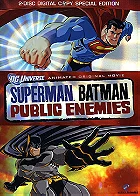 Posted : 14 years, 8 months ago on 12 September 2010 01:28
(A review of Superman/Batman: Public Enemies)
Posted : 14 years, 8 months ago on 12 September 2010 01:28
(A review of Superman/Batman: Public Enemies)Based on the Jeph Loeb and Ed McGuinness comic, Superman/Batman: Public Enemies presents a gangs-all-here voice cast that includes Tim Daly and Kevin Conroy and a plot that only slows down long enough to let our titular heroes breathe before launching into the next action sequence. It would have been nice if more time and energy had been used to give the plot room to breathe, but as a non-stop action-adventure buddy film it works like gangbusters. I also wish that the character designed didn’t rely so heavily upon McGuinness’ artistic style since every character consistently looks too bulky, too embellished, cartoony to the point of distraction (Power Girl’s body is especially distracting for her top heavy proportions).
While I really enjoyed the film, it does play out like a thirteen-year-old boys’ manic manga-inspired fever-dream team-up. When you see this new young Japanese version of Toyman, and his gadgets that help save the world, you’ll understand completely what I mean. While it was a hoot to hear Tim Daly, Kevin Conroy, Clancy Brown and CCH Pounder reprise their roles, the designs that accompany them take a minute or two to get used to. With no real reason given for Batman to team-up with and help Superman, besides the ‘greater good’ that they fight for, it’s also a little thin in the plot development. A fun time to be had, but it could have been better if it had been longer and more fleshed out.
While I really enjoyed the film, it does play out like a thirteen-year-old boys’ manic manga-inspired fever-dream team-up. When you see this new young Japanese version of Toyman, and his gadgets that help save the world, you’ll understand completely what I mean. While it was a hoot to hear Tim Daly, Kevin Conroy, Clancy Brown and CCH Pounder reprise their roles, the designs that accompany them take a minute or two to get used to. With no real reason given for Batman to team-up with and help Superman, besides the ‘greater good’ that they fight for, it’s also a little thin in the plot development. A fun time to be had, but it could have been better if it had been longer and more fleshed out.
 0 comments, Reply to this entry
0 comments, Reply to this entry
Batman: Under the Red Hood
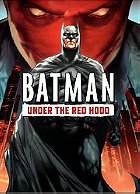 Posted : 14 years, 8 months ago on 12 September 2010 01:28
(A review of Batman: Under the Red Hood)
Posted : 14 years, 8 months ago on 12 September 2010 01:28
(A review of Batman: Under the Red Hood)I must say, this is right up there with Wonder Woman and both of the Justice League direct-to-DVD films, it could possibly even surpass them. Much like those films, Batman: Under the Red Hood has a script that is equally dramatically engaging and entertaining as an action-adventure film, excellent voice acting and richly detailed animation.
Every great Batman story sees the character engage in something that challenges him – physically, emotionally, mentally – and Under the Red Hood provides us a chance to see Batman struggle in each of those departments. It begins with the dramatic climax of A Death in the Family, the infamous storyline which showed us Batman’s greatest failure – the death of Jason Todd, and doesn’t skirt on the brutal violence. Jason Todd was always a dark, complicated character, one who dangerously balanced on the edge and more often than not swayed closer to falling in than not. When he eventually returns, darker and more violently complicated, it isn’t hard to see what events pushed him towards that eventual decision. Jensen Ackles handles most of the titular role, and he does a great job. The Red Hood takes Batman’s morally ambiguous vigilantism and combines Ra’s Al Ghul’s by-any-means-necessary and a small dose of Joker’s crazy. (Which only makes sense since Batman, Ra’s and the Joker are inevitably the fathers of this new Jason Todd, a tormented and broke psyche that Batman can’t help but feel the tiniest bit of empathy and sympathy for, as does the audience.) There aren’t many surprises in the plot points, but it’s how the character’s react and deal with them that makes it so entertaining.
The animation is sharp, clean and crisp. The flashbacks are handled really ingeniously, and present us with characters that have outfits and body types that change and evolve as they grow older, especially Jason Todd who is seen at every age – young Robin, the doomed teenage Robin and as an adult – and retains many of the same aspects throughout each incarnation, namely the angular facial features and slim build. Nightwing, also briefly seen, is finally presented without a groan-inducing mullet. It’s also nice to see the evolution of the Batmobile, Batcave and Batman’s suit.
The only real drawback are two vocal choices: Neil Patrick Harris as Nightwing, not because he’s bad, which he’s not, but because his wiseass quips and vocal tone were already used to perfection as the Flash in Justice League: The New Frontier, and John Di Maggio as the Joker, which is a poor casting decision as his voice is too deep for the character. No one can top the Mark Hamill interpretation, and perhaps every other choice is doomed to comparison. I’ve never been a fan of the Joker with a dark and rumbling voice.
Batman: Under the Red Hood presents a morally questionable villain from the Batman’s past, partly a creation of his own making, and an engaging and emotionally absorbing storyline to accompany it. Here’s hoping other heroes in the DC universe get this same kind of intelligent and absorbing treatment. Superman and Batman have each gotten several of these, why not Aquaman, the Flash or any of the others?
Every great Batman story sees the character engage in something that challenges him – physically, emotionally, mentally – and Under the Red Hood provides us a chance to see Batman struggle in each of those departments. It begins with the dramatic climax of A Death in the Family, the infamous storyline which showed us Batman’s greatest failure – the death of Jason Todd, and doesn’t skirt on the brutal violence. Jason Todd was always a dark, complicated character, one who dangerously balanced on the edge and more often than not swayed closer to falling in than not. When he eventually returns, darker and more violently complicated, it isn’t hard to see what events pushed him towards that eventual decision. Jensen Ackles handles most of the titular role, and he does a great job. The Red Hood takes Batman’s morally ambiguous vigilantism and combines Ra’s Al Ghul’s by-any-means-necessary and a small dose of Joker’s crazy. (Which only makes sense since Batman, Ra’s and the Joker are inevitably the fathers of this new Jason Todd, a tormented and broke psyche that Batman can’t help but feel the tiniest bit of empathy and sympathy for, as does the audience.) There aren’t many surprises in the plot points, but it’s how the character’s react and deal with them that makes it so entertaining.
The animation is sharp, clean and crisp. The flashbacks are handled really ingeniously, and present us with characters that have outfits and body types that change and evolve as they grow older, especially Jason Todd who is seen at every age – young Robin, the doomed teenage Robin and as an adult – and retains many of the same aspects throughout each incarnation, namely the angular facial features and slim build. Nightwing, also briefly seen, is finally presented without a groan-inducing mullet. It’s also nice to see the evolution of the Batmobile, Batcave and Batman’s suit.
The only real drawback are two vocal choices: Neil Patrick Harris as Nightwing, not because he’s bad, which he’s not, but because his wiseass quips and vocal tone were already used to perfection as the Flash in Justice League: The New Frontier, and John Di Maggio as the Joker, which is a poor casting decision as his voice is too deep for the character. No one can top the Mark Hamill interpretation, and perhaps every other choice is doomed to comparison. I’ve never been a fan of the Joker with a dark and rumbling voice.
Batman: Under the Red Hood presents a morally questionable villain from the Batman’s past, partly a creation of his own making, and an engaging and emotionally absorbing storyline to accompany it. Here’s hoping other heroes in the DC universe get this same kind of intelligent and absorbing treatment. Superman and Batman have each gotten several of these, why not Aquaman, the Flash or any of the others?
 0 comments, Reply to this entry
0 comments, Reply to this entry
The Letter
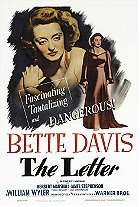 Posted : 14 years, 8 months ago on 27 August 2010 11:49
(A review of The Letter)
Posted : 14 years, 8 months ago on 27 August 2010 11:49
(A review of The Letter)Every year between 1938 and 1942 Bette Davis received an Academy Award nomination as Best Actress. That is an astounding feat when you think about it. Who else can proclaim five consecutive years in a row? Katharine Hepburn, most likely, and possibly Meryl Streep and Jack Nicholson, but that’s still a very exclusive club. And each performance was a different and unique side to Davis’ talents and charms as an actress. Jezebel was a complicated portrait of a rebellious but still proper southern belle, Dark Victory was a nice girl with an unfortunate fate, Now, Voyager was a movie where she transformed physically, spiritually and emotionally, The Little Foxes was pure acid. The Letter is yet another color and texture of Davis’ palette.
Another W. Somerset Maugham adaptation, The Letter tells the story of a married woman who kills the man she’s been having an affair with, and cons everyone into believing otherwise, until the letter shows up, which leads to a cover up, an unfair trial and, ultimately, the murder of Davis’ character. Davis does a brilliant job balancing between making everyone believe her story, and being a frigidly cold, unremorseful killer. She’s a brittle high society woman who we are waiting to watch break under the tremendous pressures. She never breaks in the traditional sense, only tries to con us more, even when she has been caught. She met with a great female opposition in Gale Sondergaard as the wife of the man Davis killed. Sondergaard is a viper quietly waiting to strike. Her face is a mask. There is no emotion beneath the surface but a coiled rage and hatred. She doesn’t strike until the very end, but she strikes with a great force. Everyone else in the cast does an admirable job, but none really standout the way that the two females do.
The Letter also features two great sequences: the opening and closing murders. The opening is a beguiling montage of a still and peaceful night that is interrupted by six gunshots. The ending features Davis walking from the backyard into the streets, where she is cornered by Sondergaard and an accomplice, stabbed, and dies in the street. All the while the party in the house celebrating her not guilty verdict for the opening murder continues to rage on, totally oblivious to the noir-like justice that has just happened.
Another W. Somerset Maugham adaptation, The Letter tells the story of a married woman who kills the man she’s been having an affair with, and cons everyone into believing otherwise, until the letter shows up, which leads to a cover up, an unfair trial and, ultimately, the murder of Davis’ character. Davis does a brilliant job balancing between making everyone believe her story, and being a frigidly cold, unremorseful killer. She’s a brittle high society woman who we are waiting to watch break under the tremendous pressures. She never breaks in the traditional sense, only tries to con us more, even when she has been caught. She met with a great female opposition in Gale Sondergaard as the wife of the man Davis killed. Sondergaard is a viper quietly waiting to strike. Her face is a mask. There is no emotion beneath the surface but a coiled rage and hatred. She doesn’t strike until the very end, but she strikes with a great force. Everyone else in the cast does an admirable job, but none really standout the way that the two females do.
The Letter also features two great sequences: the opening and closing murders. The opening is a beguiling montage of a still and peaceful night that is interrupted by six gunshots. The ending features Davis walking from the backyard into the streets, where she is cornered by Sondergaard and an accomplice, stabbed, and dies in the street. All the while the party in the house celebrating her not guilty verdict for the opening murder continues to rage on, totally oblivious to the noir-like justice that has just happened.
 0 comments, Reply to this entry
0 comments, Reply to this entry
Dark Victory
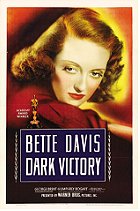 Posted : 14 years, 8 months ago on 27 August 2010 11:48
(A review of Dark Victory)
Posted : 14 years, 8 months ago on 27 August 2010 11:48
(A review of Dark Victory)In Dark Victory Bette Davis played against type: she wasn’t neurotic, she wasn’t a washed-up actress or a woman rebelling against aging, there was no unglamorous transformation and she wasn’t a bitch. She played a likeable, if slightly frivolous, socialite who slowly dies over the course of the film from a malignant brain tumor. Oh, yes, it sounds like melodramatic flim-flam, and to an extent it is, but it would take a cynic with a heart of stone to not be the tiniest bit moved by this poor-little-rich-girl.
Never really one for restraint, Davis holds herself back here. She underplays where she would normally overplay (see: Mr. Skeffington). It works, and maybe in a year without Gone With the Wind, she would have won Best Actress for this. But, at least, she got a nomination. The scene where she goes upstairs to die with quiet dignity is enough to make you reach for, at least, three tissues. Yes, this is one of those movies: a Kleenex movie if I ever saw one. And I bought it, and I was ready to cry at the end. Davis creates a likeable woman; I wanted to believe that she was cured just as much as she did. But I knew better. I didn’t want this to happen to her, she didn’t deserve an early death the way that Mildred in Of Human Bondage did.
Davis is aided with tremendous supporting performances from George Brent, as her specialist and romantic interest, and Geraldine Fitzgerald, as her best friend and assistant. The closing sequence where Davis talks Brent into leaving her alone at their home to die and demands that Fitzgerald not say one word is a series of masterful acting performances with each actor hitting the right emotional cues and crescendos to make the deception and sacrifice all the more realistic.
And if that weren’t enough, Dark Victory obviously had a lot of money, time and effort put into it. The sets, costumes, cinematography and score are all first-rate. They build her entire world and invest you into it with the loving details.
However, not everything is perfect. Humphrey Bogart, before he was Bogie, is given little to do but talk with an awkward Irish brogue. He seems out of place, especially since his New York-inflected speech never really recedes enough for us to believe in his accent in the film. He hits his dramatic moments wonderfully, but that accent is always distracting. And Ronald Regan, plainly handsome and very stiff, is given nothing to do but drink and pine after Davis. I’m not sure if he was a better politician than actor, but I know that he wasn’t very skilled at acting.
Dark Victory is a melodrama, but it is also one of the best melodramas to come out of Davis’ long filmography. To just read a synopsis of the movie is not to experience its charms. To think the film is just about a poor-little-rich-girl is to miss out on a tremendous piece of acting. It is a whole box of Kleenex picture, and sometimes that’s exactly what the soul needs.
Never really one for restraint, Davis holds herself back here. She underplays where she would normally overplay (see: Mr. Skeffington). It works, and maybe in a year without Gone With the Wind, she would have won Best Actress for this. But, at least, she got a nomination. The scene where she goes upstairs to die with quiet dignity is enough to make you reach for, at least, three tissues. Yes, this is one of those movies: a Kleenex movie if I ever saw one. And I bought it, and I was ready to cry at the end. Davis creates a likeable woman; I wanted to believe that she was cured just as much as she did. But I knew better. I didn’t want this to happen to her, she didn’t deserve an early death the way that Mildred in Of Human Bondage did.
Davis is aided with tremendous supporting performances from George Brent, as her specialist and romantic interest, and Geraldine Fitzgerald, as her best friend and assistant. The closing sequence where Davis talks Brent into leaving her alone at their home to die and demands that Fitzgerald not say one word is a series of masterful acting performances with each actor hitting the right emotional cues and crescendos to make the deception and sacrifice all the more realistic.
And if that weren’t enough, Dark Victory obviously had a lot of money, time and effort put into it. The sets, costumes, cinematography and score are all first-rate. They build her entire world and invest you into it with the loving details.
However, not everything is perfect. Humphrey Bogart, before he was Bogie, is given little to do but talk with an awkward Irish brogue. He seems out of place, especially since his New York-inflected speech never really recedes enough for us to believe in his accent in the film. He hits his dramatic moments wonderfully, but that accent is always distracting. And Ronald Regan, plainly handsome and very stiff, is given nothing to do but drink and pine after Davis. I’m not sure if he was a better politician than actor, but I know that he wasn’t very skilled at acting.
Dark Victory is a melodrama, but it is also one of the best melodramas to come out of Davis’ long filmography. To just read a synopsis of the movie is not to experience its charms. To think the film is just about a poor-little-rich-girl is to miss out on a tremendous piece of acting. It is a whole box of Kleenex picture, and sometimes that’s exactly what the soul needs.
 0 comments, Reply to this entry
0 comments, Reply to this entry
Mr. Skeffington
 Posted : 14 years, 8 months ago on 27 August 2010 11:47
(A review of Mr. Skeffington)
Posted : 14 years, 8 months ago on 27 August 2010 11:47
(A review of Mr. Skeffington)Mr. Skeffington is a star vehicle in extremis. Bette Davis’ performance is a frantic thing, always watchable and frequently spellbinding, but drunk on its own importance. There’s no true plot to accompany the bloated running time, but it’s never boring, really. It just needed a stronger director, writer and, probably, a lion tamer to keep Davis’ ego at the door so that a more reasonable plot structure and runtime could be decided upon. There is really only room for the Star, Her Role and the Vehicle to accompany it. Nothing else really matters. The “story” concerns itself with Fanny Skeffington, a vainglorious New York socialite who starts off a coquette and ends up a grotesquery from a Grand Guignol story. She’s a narcissist of the highest order who loves herself and attention from increasingly younger men first, her brother secondly (perilously close too incestuously), and everyone and everything else third. Davis clearly relishes playing Fanny once the gargoyle in her comes out. Claude Rains, always reliable, gives the best performance in the film. Tender, restrained and open-hearted, he provides an anchor to Davis’ diva-tantrum. A tidy lesson about love is shoe-horned in, but imagine if the film had focused more on one woman’s obsession with aging and staying young and beautiful instead? Those sequences still resonate today. Just look at the plastic surgery industry.
 0 comments, Reply to this entry
0 comments, Reply to this entry
The Star
 Posted : 14 years, 8 months ago on 27 August 2010 11:46
(A review of The Star)
Posted : 14 years, 8 months ago on 27 August 2010 11:46
(A review of The Star)Bette Davis allowed for every up-and-down in her personal life to play out in some roundabout way in her film career. The through line of All About Eve through What Ever Happened to Baby Jane? is only complete when we considered her Oscar nominated work in The Star. A third-rate Sunset Boulevard with lackluster writing way below Davis’ talent, which is watchable but never great. All About Eve showed us an aging Bette Davis who portrayed a woman who loved her craft and was a master of it while prettier and younger up-and-comers nipped at her heels for the spotlight first and love of the craft second. What Ever Happened to Baby Jane? offered up Bette Davis and Joan Crawford portraying their rivalry in heightened terms, and Davis as the kind of former-celebrity who can’t live without the spotlight and never really gave it up mentally. The Star shows us the middle portion. She is a washed-up, completely broke actress who will revive her career through sheer force-of-will. (She also takes wickedly funny stabs at Joan Crawford during her screen-test where she plays a spinster as young and sexy, an actress utterly refusing to admit, accept or even act her age or the appropriate age for the part.) Davis’ performance continually threatens to blow apart the whole film. A pity it’s all so cliché and the ending is such a groaner. It sees Davis’ character learn that what she really needs is the nuclear family to keep her together, and the love and protection of a good man. Funny that Davis’ life was antithetical to that. She worked until she died, and screw the men that didn't want her to and got in her way. The Star rightly got her an Oscar nomination, but it never matches her immense talent.
 0 comments, Reply to this entry
0 comments, Reply to this entry
Of Human Bondage
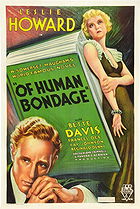 Posted : 14 years, 8 months ago on 27 August 2010 11:45
(A review of Of Human Bondage (1934))
Posted : 14 years, 8 months ago on 27 August 2010 11:45
(A review of Of Human Bondage (1934))The 1934 adaptation of W. Somerset Maugham’s seminal novel, Of Human Bondage, is notable for two things: it is widely considered the film that made Bette Davis a star, and the best of the three different adaptations of the novel (it was remade in 1946 and 1964). While there is much to laud over when it comes to the film, it also suffers greatly from the central performance by Leslie Howard and the fact that it has slipped into the public domain, meaning the film is flaw-ridden and of questionable visual and audio quality.
Of Human Bondage concerns itself with a sadomasochistic love affair (if that is the correct term for it, which it is not) between the fitfully dull Philip Carey, an Englishman studying to become a doctor, and the object of his obsession, Mildred, a vulgar and venomous waitress. She takes him for all he’s worth, uses him and spits him back out. He loves every minute of it, and lacks any kind of distinct personality, so he kind of deserves it.
Leslie Howard was always, to me, a bland and dull actor. His Ashley in Gone With the Wind was always so wishy-washy and boring that I never understood Scarlett O’Hara’s conflict in deciding between Rhett and Ashley. Rhett always seemed the obvious choice. Here that blandness works to a point. He still doesn’t emote much, and he’s a very stiff actor, but one can see how a man like him could get swept up in an obliterating force like Bette Davis’ Mildred. Davis doesn’t just walk off with the picture; she obliterates him at every turn. With her cockney accent and ability to send tremors down your spine with just the change in her eyes, Davis proved that she was far beyond the mandated roles she had been given at that time. She was a real actress. When she returns towards the end in the final throws of tuberculosis (syphilis in the novel, changed because of the Hays Code for the film), she looks like walking death. Naturally, she was ignored when it came time for the Academy Awards. Not even nominated, she was allowed as a write-in submission and placed third. She won the next year for Dangerous, a consolation prize if there ever was one. But, here it is, the first milestone of Davis’ long and illustrious career.
Of Human Bondage concerns itself with a sadomasochistic love affair (if that is the correct term for it, which it is not) between the fitfully dull Philip Carey, an Englishman studying to become a doctor, and the object of his obsession, Mildred, a vulgar and venomous waitress. She takes him for all he’s worth, uses him and spits him back out. He loves every minute of it, and lacks any kind of distinct personality, so he kind of deserves it.
Leslie Howard was always, to me, a bland and dull actor. His Ashley in Gone With the Wind was always so wishy-washy and boring that I never understood Scarlett O’Hara’s conflict in deciding between Rhett and Ashley. Rhett always seemed the obvious choice. Here that blandness works to a point. He still doesn’t emote much, and he’s a very stiff actor, but one can see how a man like him could get swept up in an obliterating force like Bette Davis’ Mildred. Davis doesn’t just walk off with the picture; she obliterates him at every turn. With her cockney accent and ability to send tremors down your spine with just the change in her eyes, Davis proved that she was far beyond the mandated roles she had been given at that time. She was a real actress. When she returns towards the end in the final throws of tuberculosis (syphilis in the novel, changed because of the Hays Code for the film), she looks like walking death. Naturally, she was ignored when it came time for the Academy Awards. Not even nominated, she was allowed as a write-in submission and placed third. She won the next year for Dangerous, a consolation prize if there ever was one. But, here it is, the first milestone of Davis’ long and illustrious career.
 0 comments, Reply to this entry
0 comments, Reply to this entry
The Queen
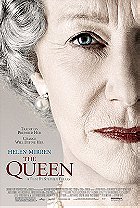 Posted : 14 years, 9 months ago on 21 August 2010 09:13
(A review of The Queen)
Posted : 14 years, 9 months ago on 21 August 2010 09:13
(A review of The Queen)Stephen Frears’ The Queen is an utterly fascinating (highly fictional) look into one of the most unknowable figureheads in all of the monarchy: the Queen Mother. Queen Elizabeth II has given her entire life to her country, and she has done so with class, selflessness and a level-headedness that befits such a position. We cannot ever really know the true woman beneath the propriety, rules, regulations, customs and idiosyncrasies of the title, but there have been numerous moments of small insight. The Queen displays what might have happened in the time shortly after Diana, Princess of Wales, died in a car accident. My sympathies stayed with her, even when her countrymen did not.
By now it has entered the cultural landscape in such a way that it’s almost impossible to remember a time when it was unfolding before you, but this story takes place in the week-long aftermath of the death of Princess Diana. We see two worlds, which often interconnect but never really understand each other completely. On one hand we have Queen Elizabeth II and the royal family trying to keep the matter private, consul and distract Princes William and Harry from the media firestorm, and trying to find the correct way to deal with the burial, funeral and all that goes along with it. The other hand tells of the story of Tony Blair, then a young upstart in the Prime Minister’s office, and his media manipulation to use the death of Diana as a springboard for his political parties ability to get in touch with the common man. Eventually, he realizes that maybe Queen Elizabeth II is right: Diana was no longer a member of the royal family, she doesn’t deserve the hubbub, pomp and circumstance that goes along with a royal death. And maybe the British public, which he helped whip into a frenzy, should treat her with some more respect and stop making such anti-monarchy sentiments. She has, afterall, dedicated her entire life and being to her country, and is as unfathomable to them as their reaction to Diana’s death is to her. She is not sheltered, but none one can really know what her personal feelings are.
Helen Mirren nails the role. From the first frame until the very last she remains in character and does her best to creature a portrait of the human being beneath the title. Is this how the real Queen Mother is? I do not know. The British do not know. But I can believe that this is a very real possibility. In a scene where she sees a large stag, impossibly beautiful and full of grace, being hunted for its size and ephemeral nature, she cries and recognizes a kindred spirit. It could come across as ham-fisted, but Mirren’s face, normally so placid and contained, twinges every so lovely. It’s the quiet moments and not just the physical and vocal transformations that allowed her to justifiably win that Oscar. But poor Michael Sheen…he got left behind during awards season. Tony Blair is a man unafraid of the media spotlight and knows what the power of it can accomplish, perhaps since he’s so familiar to us Sheen’s performance (his second Blair performance of three, so far) came across as mimicry and not a real portrait. I disagree. But, alas, I am not a member of the AMPAS, Golden Globes, SAG, BFCA or BAFTA.
The Queen is full of stellar performances, the supporting cast on the monarch side alone is first-rate and Blair’s staff and family is full of spot-on portrayals, a smart script, and emotionally connectivity to spellbind any of us. God save the Queen, I mean it, man.
By now it has entered the cultural landscape in such a way that it’s almost impossible to remember a time when it was unfolding before you, but this story takes place in the week-long aftermath of the death of Princess Diana. We see two worlds, which often interconnect but never really understand each other completely. On one hand we have Queen Elizabeth II and the royal family trying to keep the matter private, consul and distract Princes William and Harry from the media firestorm, and trying to find the correct way to deal with the burial, funeral and all that goes along with it. The other hand tells of the story of Tony Blair, then a young upstart in the Prime Minister’s office, and his media manipulation to use the death of Diana as a springboard for his political parties ability to get in touch with the common man. Eventually, he realizes that maybe Queen Elizabeth II is right: Diana was no longer a member of the royal family, she doesn’t deserve the hubbub, pomp and circumstance that goes along with a royal death. And maybe the British public, which he helped whip into a frenzy, should treat her with some more respect and stop making such anti-monarchy sentiments. She has, afterall, dedicated her entire life and being to her country, and is as unfathomable to them as their reaction to Diana’s death is to her. She is not sheltered, but none one can really know what her personal feelings are.
Helen Mirren nails the role. From the first frame until the very last she remains in character and does her best to creature a portrait of the human being beneath the title. Is this how the real Queen Mother is? I do not know. The British do not know. But I can believe that this is a very real possibility. In a scene where she sees a large stag, impossibly beautiful and full of grace, being hunted for its size and ephemeral nature, she cries and recognizes a kindred spirit. It could come across as ham-fisted, but Mirren’s face, normally so placid and contained, twinges every so lovely. It’s the quiet moments and not just the physical and vocal transformations that allowed her to justifiably win that Oscar. But poor Michael Sheen…he got left behind during awards season. Tony Blair is a man unafraid of the media spotlight and knows what the power of it can accomplish, perhaps since he’s so familiar to us Sheen’s performance (his second Blair performance of three, so far) came across as mimicry and not a real portrait. I disagree. But, alas, I am not a member of the AMPAS, Golden Globes, SAG, BFCA or BAFTA.
The Queen is full of stellar performances, the supporting cast on the monarch side alone is first-rate and Blair’s staff and family is full of spot-on portrayals, a smart script, and emotionally connectivity to spellbind any of us. God save the Queen, I mean it, man.
 0 comments, Reply to this entry
0 comments, Reply to this entry
 Login
Login
 Home
Home 95 Lists
95 Lists 1531 Reviews
1531 Reviews Collections
Collections